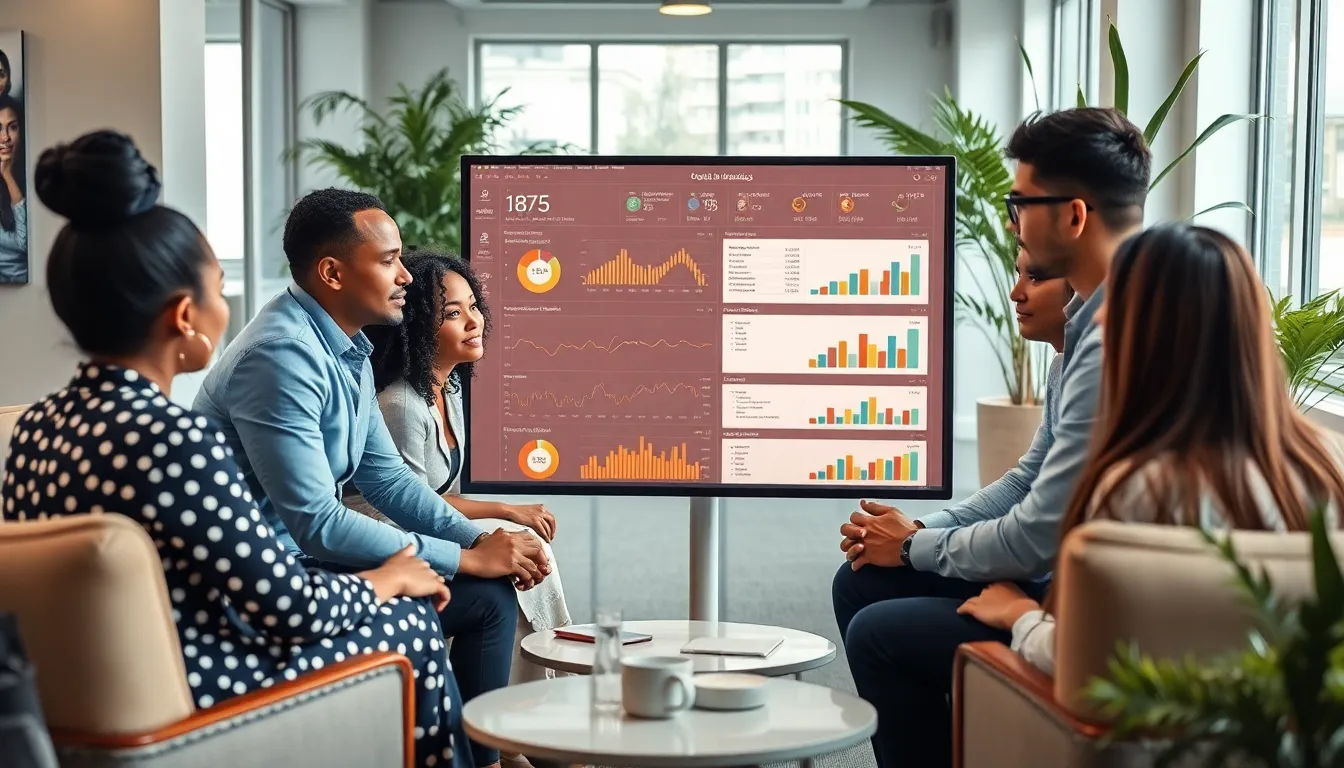In the fast-paced world of SaaS, data is the new gold, and analytics dashboards are the treasure maps guiding businesses to success. Imagine having a crystal ball that reveals customer behavior, sales trends, and performance metrics—all in one place. That’s exactly what a well-designed SaaS analytics dashboard offers. It’s like having a personal assistant who not only organizes your data but also serves it up with a side of insights.
But let’s be real: navigating data can feel like trying to read a novel in a foreign language. That’s where the magic of a user-friendly dashboard comes in. With the right tools, turning complex data into actionable insights becomes a breeze. So, buckle up as we dive into the world of SaaS analytics dashboards, where numbers transform into narratives, and every click brings clarity.
Table of Contents
ToggleOverview of SaaS Analytics Dashboard
SaaS analytics dashboards consolidate data from various sources, presenting essential information in a visual format. These dashboards empower organizations to monitor performance metrics, customer interactions, and business trends effortlessly. They transform raw data into actionable insights, enabling informed decision-making.
Many key features enhance the utility of SaaS analytics dashboards. Data visualization tools, such as graphs and charts, simplify the interpretation of complex data sets. User customization options allow teams to tailor views according to their specific needs. Integrations with different software tools further streamline data collection and analysis processes.
Real-time updates represent another significant advantage of these dashboards. Businesses can track performance instantly, identifying trends as they emerge. Immediate access to metrics allows teams to respond quickly to market changes or customer demands.
Analytics capabilities on these platforms extend beyond basic reporting. Advanced analytics tools help uncover hidden patterns and anomalies within the data. Predictive analytics provide foresight, enabling businesses to anticipate future trends based on historical data.
Security remains a critical consideration when utilizing SaaS analytics dashboards. Providers implement robust security measures to protect sensitive business data. Regular updates and compliance with industry standards ensure the integrity of the data managed within these dashboards.
Incorporation of cloud technology enhances connectivity and accessibility. Users can access dashboards remotely, facilitating collaboration across teams. This flexibility supports enhanced productivity, as stakeholders engage with real-time data no matter their location.
SaaS analytics dashboards represent an essential tool for businesses aiming to harness the power of data. Their ability to simplify complex information directly impacts strategic planning and operational efficiency.
Key Features of SaaS Analytics Dashboards

SaaS analytics dashboards offer essential features that enhance data-driven decision making. Key elements include data visualization tools and customization options.
Data Visualization Tools
Data visualization tools play a vital role in transforming complex metrics into intuitive graphics. Users can view trends through charts, graphs, and heat maps, streamlining comprehension of large datasets. Engaging visual elements make it easier to identify anomalies and patterns in real time. These tools support various data types, accommodating everything from sales figures to customer engagement scores, which improves analysis efficiency. Customizable layouts enhance user experience, allowing stakeholders to focus on relevant information. Dashboards can update dynamically, ensuring that visuals reflect the most current data.
Customization Options
Customization options empower users to tailor dashboards to fit specific needs. Organizations can adjust layouts, color schemes, and designated metrics to reflect unique branding or priorities. Widgets can be added and removed based on individual preferences, ensuring the displayed information aligns with business goals. Custom alerts notify users of significant changes, facilitating timely actions. By allowing team members to create personalized views, SaaS analytics dashboards foster collaboration and improve overall data utilization. These features help businesses focus on relevant insights, enhancing strategic planning and operational effectiveness.
Benefits of Using SaaS Analytics Dashboards
SaaS analytics dashboards provide several advantages that enhance business operations. These benefits include improved decision-making and significant time and cost efficiency.
Improved Decision-Making
Data-driven decisions come with the use of SaaS analytics dashboards. They compile real-time performance metrics, enabling quick assessments. Decision-makers access relevant information promptly, allowing for timely strategic adjustments. Predictive analytics features identify trends, equipping organizations with foresight to anticipate market shifts. Visual representations of data simplify understanding, making it easier to grasp complex metrics. Clarity in visualizations promotes more informed discussions during team meetings, further enhancing collaboration. Overall, well-structured dashboards empower teams to make confident choices based on comprehensive insights.
Time and Cost Efficiency
Organizations experience heightened efficiency through SaaS analytics dashboards. Gathering information from various platforms happens seamlessly, reducing the time spent on manual data collection. Users save resources by having consolidated data in one visual interface. By minimizing the effort required for data analysis, teams can focus on more strategic initiatives. Rapid insights enable quick reactions to changing market conditions, assisting businesses in staying competitive. Additionally, scalable solutions allow companies to adjust their analytics capabilities based on growth. This adaptability supports both financial and operational efficiency in the long term.
Leading SaaS Analytics Dashboard Solutions
SaaS analytics dashboards provide valuable insights through various platforms. Several popular solutions cater to different business needs.
Comparison of Popular Platforms
Table 1 summarizes key features of leading SaaS analytics dashboard platforms.
| Platform | Key Feature | Target Users |
|---|---|---|
| Tableau | Advanced data visualization | Data analysts |
| Looker | Integrated data modeling | Business intelligence teams |
| Google Data Studio | Seamless Google integration | Small businesses |
| Power BI | Extensive Microsoft ecosystem integration | Enterprises |
| Domo | Real-time collaboration | Cross-functional teams |
These platforms vary in their capabilities, from advanced visualizations to integrated modeling options. Users can choose based on their specific analytics requirements.
User Experience and Interface
User experience enhances the effectiveness of SaaS analytics dashboards. Intuitive interfaces capture attention and promote user engagement.
Table 2 highlights aspects that improve user experience.
| Platform | Interface Quality | Customization Options |
|---|---|---|
| Tableau | Highly interactive | Extensive |
| Looker | Simplified navigation | Moderate |
| Google Data Studio | User-friendly | Very customizable |
| Power BI | Feature-rich | High degree of |
| Domo | Clean layout | Flexible |
An engaging interface assists users in navigating data easily. Customization options allow users to tailor dashboards to their needs.
SaaS analytics dashboards are vital for businesses aiming to thrive in a data-centric landscape. By transforming complex data into clear visual narratives, these tools enable organizations to make informed decisions quickly. The ability to customize dashboards and integrate various data sources enhances user experience and collaboration across teams.
With real-time updates and predictive analytics, companies can stay ahead of market trends and customer needs. As businesses continue to evolve, leveraging the power of SaaS analytics dashboards will be crucial for maintaining operational efficiency and driving strategic growth. Embracing these solutions not only streamlines decision-making but also fosters a culture of data-driven insights that can propel organizations forward.





